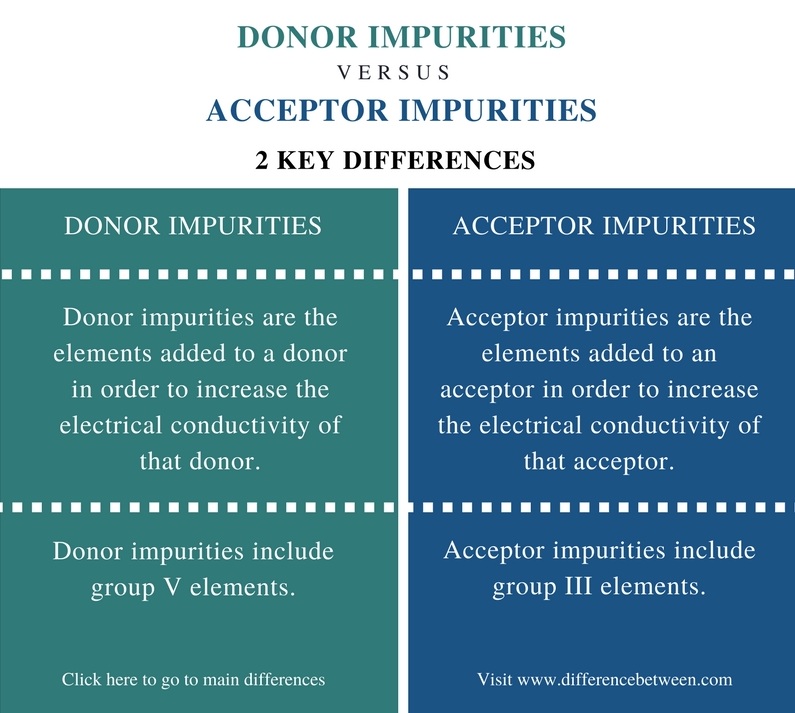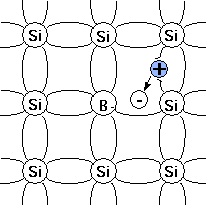The key difference between donor and acceptor impurities is that the elements in group V of the periodic table typically act as donor impurities whereas elements in group III typically act as acceptor impurities.
Doping is the process that adds impurities to a semiconductor. Doping is important in increasing the conductivity of the semiconductor. There are two main forms of doping, and they are donor doping and acceptor doping. Donor doping adds impurities to the donor whereas the acceptor doping adds impurities to the acceptor.

CONTENTS
1. Overview and Key Difference
2. What are Donor Impurities
3. What are Acceptor Impurities
4. Side by Side Comparison – Donor vs Acceptor Impurities in Tabular Form
5. Summary
What are Donor Impurities?
Donor impurities are the elements added to a donor to increase the electrical conductivity of that donor. The elements in group V of the periodic table are the common donor impurities. A donor is an atom or group of atoms that can form n-type regions when added to a semiconductor. A common example is a silicon (Si).

Figure 1: Presence of a Donor in a Silicone Lattice
The group V elements that often serve as donor impurities include arsenic (As), phosphorus (P), bismuth (Bi), and antimony (Sb). These elements have five electrons in their outermost electron shell (there are five valence electrons). When added one of these atoms to a donor such as silicon, the impurity replaces the silicon atom, forming four covalent bonds. But, now there is a free electron since there were five valence electrons. Therefore, this electron stays as a free electron, which increases the conductivity of the semiconductor. Furthermore, the number of impurity atoms determines the number of free electrons present in the donor.
What are Acceptor Impurities?
Acceptor impurities are the elements added to an acceptor to increase the electrical conductivity of that acceptor. The elements in group III are common as acceptor impurities. The elements in group III include aluminum (Al), boron (B), and gallium (Ga). An acceptor is a dopant which forms p-type regions when added to a semiconductor. These atoms have three valence electrons in their outermost electron shells.

Figure 2: Presence of an Acceptor in a Silicon Lattice
When added one of the impurity atoms such as aluminum to an acceptor, it replaces the silicon atoms in the semiconductor. Before this addition, the silicon atom has four covalent bonds around it. When aluminum takes the position of silicon, the aluminum atom forms only three covalent bonds, which in turn, results in a missing covalent bond. This creates a vacant point or a hole. However, these holes are useful in conducting electricity. When the number of impurity atoms added increases, the number of holes present in the semiconductor also increases. This addition, in turn, increases the conductivity. After the completion of the doping process, the semiconductor becomes an extrinsic semiconductor.
What is the Difference Between Donor and Acceptor Impurities?
Donor vs Acceptor Impurities | |
| Donor impurities are the elements added to a donor to increase the electrical conductivity of that donor. | Acceptor impurities are the elements added to an acceptor to increase the electrical conductivity of that acceptor. |
| Common Impurities | |
| Group V elements | Group III elements |
| Examples of Impurities | |
| Arsenic (As), phosphorus (P), bismuth (Bi), and antimony (Sb). | Aluminium (Al), boron (B), and gallium (Ga) |
| Process | |
| Increase the free electrons in the semiconductor. | Increase the holes present in the semiconductor. |
| Valence Electrons | |
| Atoms have five valence electrons. | Atoms have three valence electrons. |
| Covalent Bonding | |
| Forms four covalent bonds inside the semiconductor, leaving the fifth electron as a free electron. | Forms three covalent bonds inside the semiconductor, leaving a hole where a covalent bond is missing. |
Summary – Donor vs Acceptor Impurities
Semiconductors are the materials which are conductive between an insulator that are non-conductors and metals that are conductors. Donors and acceptors are dopants that form conductive regions in semiconductors. The doping of donor and acceptor are processes that increase the electrical conductivity of the semiconductor. The key difference between donor and acceptor impurities is that the elements in group III of the periodic table act as donor impurities whereas elements in group V act as acceptor impurities.
Reference:
1. “Difference between Donor and Acceptor Impurities in Semiconductor.” Physicsabout.com, 23 Dec. 2017, Available here.
2. Donor and Acceptor Impurities in Semiconductor. Available here.
3. “Acceptor (Semiconductors).” Wikipedia, Wikimedia Foundation, 3 Mar. 2018, Available here.
4. “Donor (Semiconductors).” Wikipedia, Wikimedia Foundation, 17 Feb. 2018, Available here.
Image Courtesy:
1. “Acceptor in Si lattice” By Karolkalna at the English Wikipedia, (CC BY-SA 3.0) via Commons Wikimedia
2. “Donor in Si lattice” By Karolkalna at the English Wikipedia (CC BY-SA 3.0) via Commons Wikimedia
ncG1vNJzZmivp6x7pbXFn5yrnZ6YsqOx07CcnqZemLyue8OinZ%2Bdopq7pLGMm5ytr5Wau26wzqemq2WRo7FurcKcnKmsn6d6qrnPrqmirJmawHA%3D